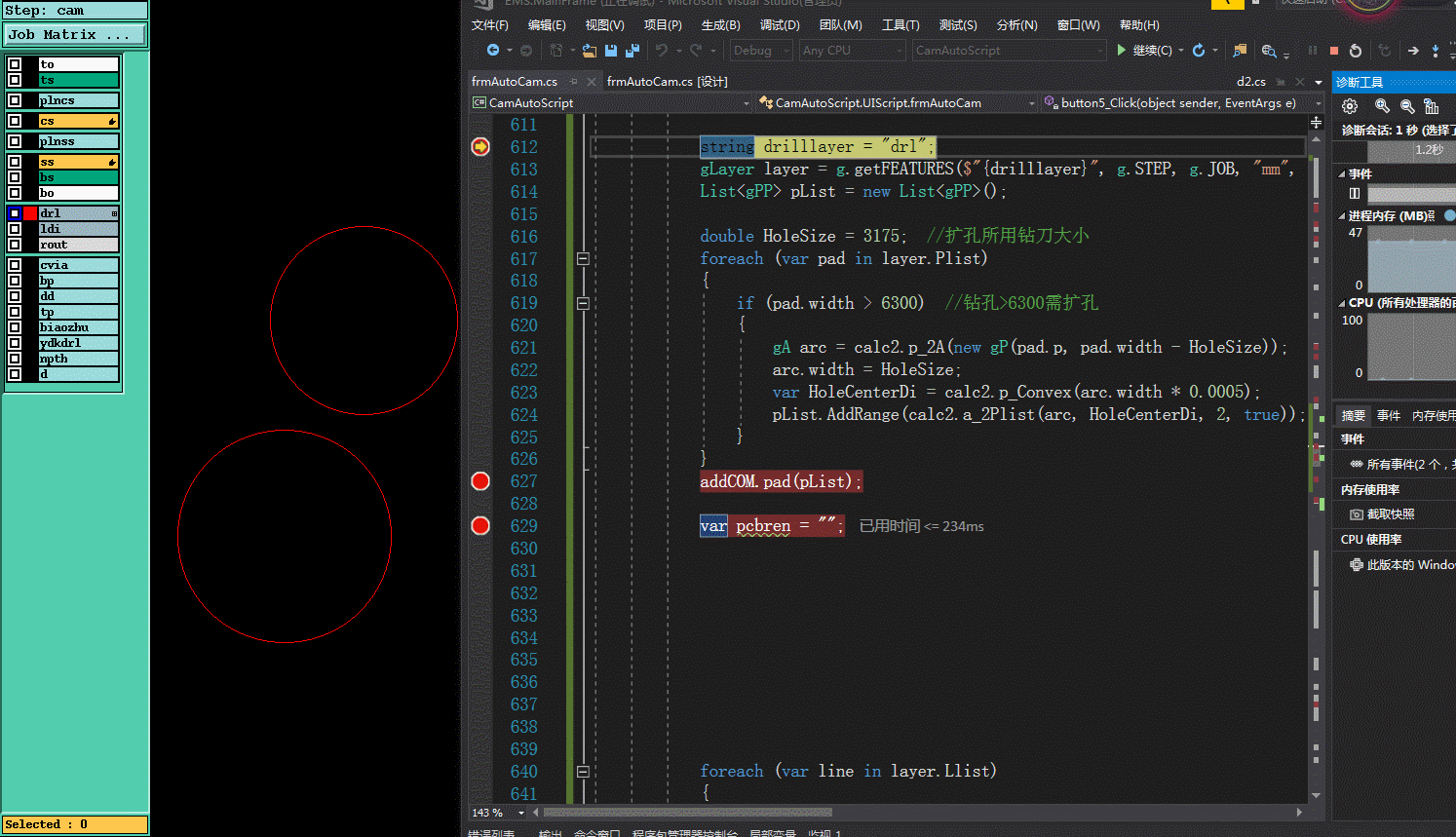PCB genesis 大孔扩孔(不用G84命令)实现方法
PCB钻孔时,当钻刀>6.3mm时,超出钻孔范围,钻孔工序是没有这么大的钻刀,当这种情况,工程CAM会都采用G84命令用小孔扩孔的方式制作, 在这里介绍一种如果不用G84命令,用程序实现将大孔生成小孔钻孔达到扩孔的目的。
一.我们先了解一下G84命令扩孔
孔尺寸大小

孔密度

连一篇文章有关于孔数计算方式: https://www.cnblogs.com/pcbren/p/9379178.html
二.求解思路
1.通过孔密度,求出孔与孔中心距离
2.求出单次增量方位角
3.以大孔中心为,长度为(大孔半径-小孔半径), 任选择一个方位角作为起始方位角,并增加一个起始孔,并围绕这个起始方位角不断递增方位角,直到360度递增完成后即结束。
三.C#简易代码实现:
1.扩孔钻孔代码

string drilllayer = "drl"; gLayer layer = g.getFEATURES($"{drilllayer}", g.STEP, g.JOB, "mm", true); List<gPP> pList = new List<gPP>(); double HoleSize = 3175; //扩孔所用钻刀大小 foreach (var pad in layer.Plist) { if (pad.width > 6300) //钻孔>6300需扩孔 { gA arc = calc2.p_2A(new gP(pad.p, pad.width - HoleSize)); arc.width = HoleSize; var HoleCenterDi = calc2.p_Convex(arc.width * 0.0005)*3; pList.AddRange(calc2.a_2Plist(arc, HoleCenterDi, 2, true)); } } addCOM.pad(pList);
2.计算函数

/// <summary> /// 通过孔半径与凸高位求 孔中心距 /// </summary> /// <param name="Rradius">孔半径</param> /// <param name="tol_">凸位高度值</param> /// <returns></returns> public double p_Convex(double Rradius, double tol_ = 0.0127) { return Math.Sqrt(Math.Pow(Rradius, 2) - Math.Pow(Rradius - tol_, 2)) * 2; } /// <summary> /// 求方位角 /// </summary> /// <param name="ps"></param> /// <param name="pe"></param> /// <returns></returns> public double p_ang(gPoint ps, gPoint pe) { double a_ang = Math.Atan((pe.y - ps.y) / (pe.x - ps.x)) / Math.PI * 180; //象限角 转方位角 计算所属象限 并求得方位角 if (pe.x >= ps.x && pe.y >= ps.y) //↗ 第一象限 { return a_ang; } else if (!(pe.x >= ps.x) && pe.y >= ps.y) // ↖ 第二象限 { return a_ang + 180; } else if (!(pe.x >= ps.x) && !(pe.y >= ps.y)) //↙ 第三象限 { return a_ang + 180; } else if (pe.x >= ps.x && !(pe.y >= ps.y)) // ↘ 第四象限 { return a_ang + 360; } else { return a_ang; } }//求方位角 /// <summary> /// 求增量坐标 /// </summary> /// <param name="ps">起点</param> /// <param name="val">增量值</param> /// <param name="ang_direction">角度</param> /// <returns></returns> public gPP p_val_ang(gPP ps, double val, double ang_direction) { gPP pe = ps; pe.p.x = ps.p.x + val * Math.Cos(ang_direction * Math.PI / 180); pe.p.y = ps.p.y + val * Math.Sin(ang_direction * Math.PI / 180); return pe; } /// <summary> /// 弧Arc 转点P组集 /// </summary> /// <param name="a"></param> /// <param name="val_">此数值表示:分段数值</param> /// <param name="type_">代表值数值类型 【0】弧长 【1】角度 【2】弦长 </param> /// <param name="is_avg">是否平均分布 </param> /// <returns></returns> public List<gPP> a_2Plist(gA a, double val_ = 0.1d, int type_ = 0, bool is_avg = false) { List<gPP> list_point = new List<gPP>(); gPP tempP; tempP.p = a.ps; tempP.symbols = a.symbols; tempP.width = a.width; list_point.Add(tempP); double avg_count; double angle_val = 0; double rad_ = p2p_di(a.pc, a.pe); double sum_alge = a_Angle(a); if (type_ == 1) // 【1】角度 { angle_val = val_; avg_count = (int)(Math.Ceiling(sum_alge / angle_val)) - 1; // 总角度/单角度 } else if (type_ == 2) //【2】弦长 { angle_val = Math.Asin(val_ / (rad_ * 2)) * 360 / pi; avg_count = (int)(Math.Ceiling(sum_alge / angle_val)) - 1; // 总角度/单角度 } else // 【0】弧长 { angle_val = val_ * 180 / (pi * rad_); avg_count = (int)(Math.Ceiling(sum_alge / angle_val)) - 1; // 总角度/单角度 //avg_count = (int)(Math.Ceiling(a_Lenght(a) / val_)) - 1; // 或 总弧长/单弧长 } if (is_avg) angle_val = sum_alge / avg_count; if (avg_count > 1) { gPP centerP = tempP; centerP.p = a.pc; double angle_s = p_ang(a.pc, a.ps); if (a.ccw) { angle_val = 0 - angle_val; } for (int i = 1; i < avg_count; i++) { tempP = p_val_ang(centerP, rad_, angle_s - angle_val * i); list_point.Add(tempP); } } if (!(zero(a.ps.x - a.pe.x) && zero(a.ps.y - a.pe.y))) { tempP.p = a.pe; list_point.Add(tempP); } return list_point; } /// <summary> /// 返回两点之间欧氏距离 /// </summary> /// <param name="p1"></param> /// <param name="p2"></param> /// <returns></returns> public double p2p_di(gPoint p1, gPoint p2) { return Math.Sqrt((p1.x - p2.x) * (p1.x - p2.x) + (p1.y - p2.y) * (p1.y - p2.y)); } /// <summary> /// 求弧Arc圆心角 //后续改进 用叉积 与3P求角度求解 验证哪个效率高 /// </summary> /// <param name="a"></param> /// <returns></returns> public double a_Angle(gA a) { double angle_s, angle_e, angle_sum; if (a.ccw) { angle_s = p_ang(a.pc, a.pe); angle_e = p_ang(a.pc, a.ps); } else { angle_s = p_ang(a.pc, a.ps); angle_e = p_ang(a.pc, a.pe); } if (angle_s == 360) { angle_s = 0; } if (angle_e >= angle_s) angle_sum = 360 - Math.Abs(angle_s - angle_e); else angle_sum = Math.Abs(angle_s - angle_e); return angle_sum; } /// <summary> /// 检查值决对值 小于 (eps = 0.001) 浮点误差处理 /// </summary> /// <param name="x"></param> /// <returns></returns> public bool zero(double x) { return (((x) > 0 ? (x) : (-x)) < eps); }
3.Point,PAD,Arc数据结构

/// <summary> /// 精简 PAD 数据类型 /// </summary> public struct gPP { public gPP(double x_val, double y_val, double width_) { this.p = new gPoint(x_val, y_val); this.symbols = "r"; this.width = width_; } public gPP(gPoint p_, double width_) { this.p = p_; this.symbols = "r"; this.width = width_; } public gPP(gPoint p_, string symbols_, double width_) { this.p = p_; this.symbols = symbols_; this.width = width_; } public gPoint p; public string symbols; public double width; public static gPP operator +(gPP p1, gPP p2) { p1.p += p2.p; return p1; } public static gPP operator +(gPP p1, gPoint p2) { p1.p += p2; return p1; } public static gPP operator -(gPP p1, gPP p2) { p1.p -= p2.p; return p1; } public static gPP operator -(gPP p1, gPoint p2) { p1.p -= p2; return p1; } } /// <summary> /// 点 数据类型 (XY) /// </summary> public struct gPoint { public gPoint(gPoint p_) { this.x = p_.x; this.y = p_.y; } public gPoint(double x_val, double y_val) { this.x = x_val; this.y = y_val; } public double x; public double y; public static gPoint operator +(gPoint p1, gPoint p2) { p1.x += p2.x; p1.y += p2.y; return p1; } public static gPoint operator -(gPoint p1, gPoint p2) { p1.x -= p2.x; p1.y -= p2.y; return p1; } } /// <summary> /// ARC 数据类型 /// </summary> public struct gA { public gA(double ps_x, double ps_y, double pc_x, double pc_y, double pe_x, double pe_y, double width_, bool ccw_) { this.ps = new gPoint(ps_x, ps_y); this.pc = new gPoint(pc_x, pc_y); this.pe = new gPoint(pe_x, pe_y); this.negative = false; this.ccw = ccw_; this.symbols = "r"; this.attribut = string.Empty; this.width = width_; } public gA(gPoint ps_, gPoint pc_, gPoint pe_, double width_, bool ccw_ = false) { this.ps = ps_; this.pc = pc_; this.pe = pe_; this.negative = false; this.ccw = ccw_; this.symbols = "r"; this.attribut = string.Empty; this.width = width_; } public gPoint ps; public gPoint pe; public gPoint pc; public bool negative;//polarity-- positive negative public bool ccw; //direction-- cw ccw public string symbols; public string attribut; public double width; public static gA operator +(gA arc1, gPoint move_p) { arc1.ps += move_p; arc1.pe += move_p; arc1.pc += move_p; return arc1; } public static gA operator +(gA arc1, gP move_p) { arc1.ps += move_p.p; arc1.pe += move_p.p; arc1.pc += move_p.p; return arc1; } public static gA operator -(gA arc1, gPoint move_p) { arc1.ps -= move_p; arc1.pe -= move_p; arc1.pc -= move_p; return arc1; } public static gA operator -(gA arc1, gP move_p) { arc1.ps -= move_p.p; arc1.pe -= move_p.p; arc1.pc -= move_p.p; return arc1; } }
四.实现效果

作者:pcbren 微信号:yadnfku QQ号: 254566449

博客地址:https://www.cnblogs.com/pcbren/
声明:本博客原创文字只代表本人工作中在某一时间内总结的观点或结论,与本人所在单位没有直接利益关系。非商业,未授权,贴子请以现状保留,转载时必须保留此段声明,且在文章页面明显位置给出原文连接。
如果大家感觉我的博文对大家有帮助,请推荐支持一把。





 浙公网安备 33010602011771号
浙公网安备 33010602011771号